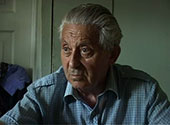
Arkadii Burshtein was born in Sobolivka in 1928. His father was a tailor. He attended a Yiddish school for four years, and then finished his education in a Ukrainian school. He survived in labor camps in the Reichkommissariat Ukraine before making his way into Transnistria. After the war he returned to Haysyn, where he worked as chief engineer in a garment factory.
Other Interviews:
Sobolivka AncedoteSobolivka
My Grandfather and the Priest
"they wanted us to stay alive."
Speaking Yiddish
The Mass Grave in Sobolivka
Arkadii's Gefilte Fish
My Grandfather’s Observance
Haysyn, Ukraine
The Jewish Sections of the Communist Party closed some 650 synagogues throughout the entire Soviet Union in the 1920s, but in 1926 there were still more than 1,000 functioning in Ukraine alone, with more than 800 rabbis; most small towns in Ukraine were still left with houses of worship until the late 1930s. These included not only official synagogues established by dvatsatki (groups of twenty worshippers authorized to open a synagogue), but also numerous other prayer quorums (minyans) that met officially as “associations,” for which a permanent building was not required, and many more that met unofficially in private homes orplaces of business, often changing locations every day in order to avoid detection.
With the end of the New Economic Policy and the dissolution of the Jewish Sections in 1929, the futures of synagogues and Jewish communal property in Ukraine were placed under the auspices of the All-Ukrainian Central Executive Committee of National Minorities, based in Kharkiv, which worked with a vengeance to close remaining synagogues. The wave of synagogue closures and mass arrests of most of the remaining rabbis during the Great Terror of the late 1930s was far more severe than that of the late 1920s.
As Arkadii Burshtein explains in this clip about the synagogue in his native Sobolivka, the confiscation of synagogues failed to completely eradicate Jewish religious practice. The congregation of Sobolivka simply moved the services from the public space of the synagogue into private homes.
Indeed, many Jewish prayer quorums, or minyans, simply moved underground. There are no rites or rituals in Judaism that can only be performed inside a synagogue; it is the community, as manifested in the minyan, that is sacred, not the structure it meets in. The presence of a minyan and a Torah scroll renders any building sacred, allowing for complete fulfillment of all rituals. Thus, when a synagogue was transformed into a sports complex or a movie theater, the faithful could simply migrate elsewhere. This flexibility and mobility are factors that have helped the Jewish religion survive innumerable persecutions and transformations. By contrast, although the Christian Orthodox majority was also able to reconstitute portions of their belief underground, in the absence of priests and churches major religious accommodations needed to be made. Source: Jeffrey Veidlinger, In the Shadow of the Shtetl: Small-Town Jewish Life in Soviet Ukraine (Indiana University Press, 2013)
